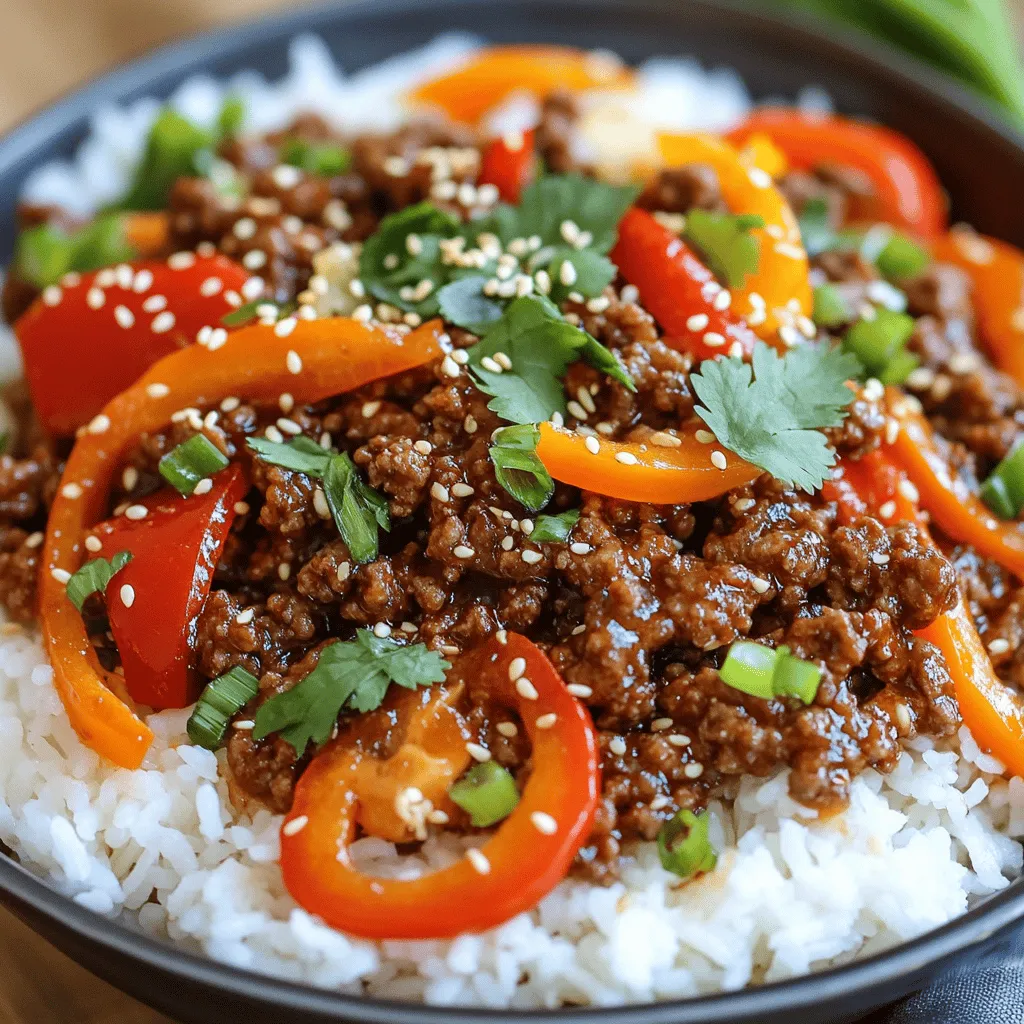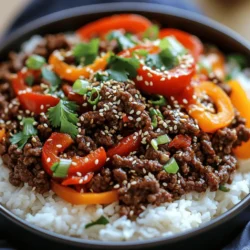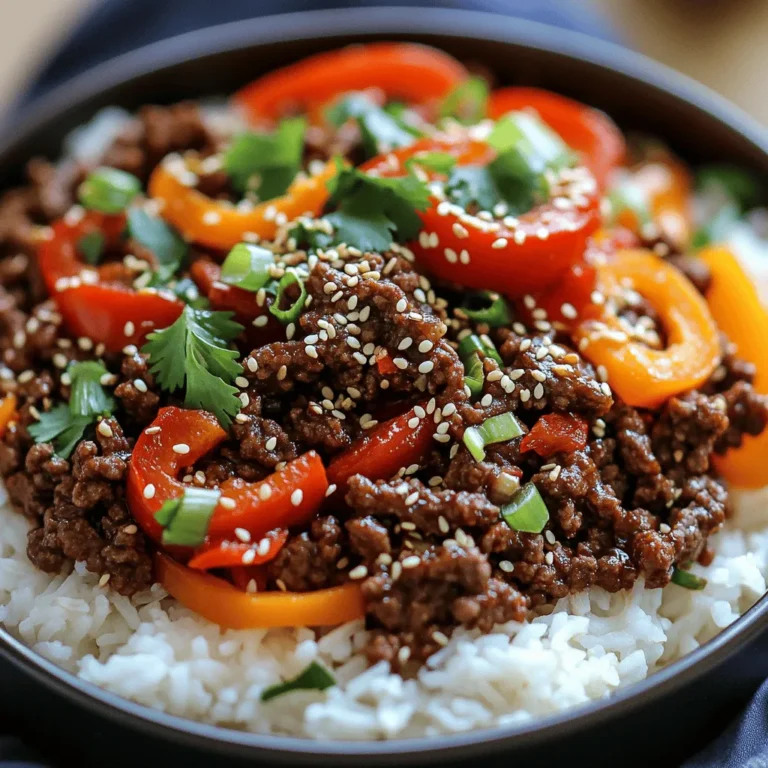Are you ready to spice up your dinner routine? With my Spicy Korean Beef Bowls, you can serve a delicious meal in no time! This easy recipe combines tender ground beef, fresh veggies, and a flavorful sauce that packs a punch. You’ll love how simple it is to make and how tasty it turns out. Let’s dive into the ingredients and get cooking!
Ingredients
Main Ingredients
– 1 lb ground beef (80/20 blend)
– 1 carrot, julienned
– 1 bell pepper (red or yellow), sliced
– 2 green onions, chopped
– 2 tablespoons sesame oil
– 3 cloves garlic, minced
– 1-inch piece of ginger, grated
Sauce Components
– 3 tablespoons soy sauce
– 1 tablespoon gochujang (Korean chili paste)
– 2 tablespoons brown sugar
– 1 teaspoon rice vinegar
Garnishes
– Sesame seeds
– Fresh cilantro
Gather these ingredients to create a tasty meal. The ground beef gives the dish a rich flavor. The vegetables add color and crunch. Sesame oil, garlic, and ginger create a strong flavor base. The sauce combines savory and sweet notes with soy sauce, gochujang, brown sugar, and rice vinegar. Finally, sesame seeds and cilantro offer a fresh finish. Enjoy mixing these components to build your spicy Korean beef bowls!
Step-by-Step Instructions
Preparing the Flavor Base
– Heating the skillet
Start by placing a large skillet on medium heat. Add two tablespoons of sesame oil. Let the oil warm up for a minute.
– Cooking garlic and ginger
Once the oil is hot, add three cloves of minced garlic and one-inch grated ginger. Cook for about 1-2 minutes. Stir until you smell that delicious aroma.
Cooking the Beef
– Browning the ground beef
Increase the heat to medium-high. Add one pound of ground beef to the skillet.
– Breaking apart and mixing
Use a spatula to break the beef apart. Cook for about 5-7 minutes until it turns brown. Stir occasionally for even cooking.
Combining the Sauce and Vegetables
– Making the sauce mixture
In a small bowl, whisk together three tablespoons of soy sauce, one tablespoon of gochujang, two tablespoons of brown sugar, and one teaspoon of rice vinegar. This mix adds a sweet and spicy kick.
– Adding vegetables and cooking time
Toss in one julienned carrot and one sliced bell pepper. Mix well and cook for another 3-4 minutes. The veggies should be tender but still crisp.
Tips & Tricks
Cooking Techniques
To get the best flavor, use a large, heavy skillet. A cast-iron pan works well. It heats evenly and gives the beef a nice sear. When cooking, make sure to keep your heat steady. This helps the beef brown without burning.
When you add vegetables, keep them crisp. Cook them for just a few minutes. This way, they stay bright and crunchy. A quick stir helps, so they don’t overcook.
Flavor Enhancements
You can add optional spices for a unique twist. Try sesame seeds for a nutty flavor. Adding chopped chili can boost the heat. Adjust the spice level with gochujang. If you want it spicier, add more gochujang. For a milder dish, use less.
Presentation Tips
To make your dish look great, serve it in deep bowls. The colorful beef and veggies will pop against the white rice. Add lime wedges on the side. They give a fresh kick when squeezed over the dish. This makes it look tasty and bright!

Variations
Protein Substitutions
You can swap out ground beef for other proteins. Chicken works well. Use ground or diced chicken for a lighter dish. Tofu is a great option for vegetarians. Just cube firm tofu and cook until golden. You can also try plant-based meat alternatives. These options keep the flavors but fit different diets.
Dietary Modifications
If you need gluten-free options, choose tamari instead of soy sauce. It gives a similar taste without gluten. For low-carb meals, skip the rice. Instead, serve the spicy beef with sautéed cauliflower rice. This way, you keep the flavor but lower the carbs.
Regional Variations
Korean cooking has many unique flavors. You can try adding different condiments, like ssamjang or kimchi. These add depth to the dish. Seasonal vegetables can also change the dish. Use zucchini in summer or sweet potatoes in fall. Each change brings a new taste and keeps it fresh.
Storage Info
Refrigeration Tips
Store leftovers in airtight containers. This keeps them fresh and tasty. You should eat them within three days. Label the containers with the date. This helps you keep track of how long they last.
Freezing Guidelines
To freeze the beef mixture, let it cool first. Place it in freezer-safe bags. Squeeze out excess air before sealing. It will stay good for up to three months. To reheat, thaw overnight in the fridge. Heat it in a skillet over medium heat. Stir until it’s hot all the way through.
Meal Prep Ideas
Batch cook the beef mixture ahead of time. Portion it out into containers. This makes quick meals easy. Just add rice and veggies when you’re ready to eat. You can also mix in extra toppings for variety.
FAQs
What is gochujang and where can I find it?
Gochujang is a thick, red paste made from chili powder, glutinous rice, fermented soybeans, and salt. It adds a sweet and spicy flavor to dishes. You can find it in Asian markets or the international aisle of most grocery stores. If you need a substitute, mix red pepper flakes with miso paste and a bit of sugar. This blend offers similar heat and sweetness.
Can I make Spicy Korean Beef Bowls in advance?
Yes, you can make Spicy Korean Beef Bowls in advance. Cook the beef and veggies, then store them in an airtight container. Keep the rice separate for best results. Refrigerate them for up to three days. Reheat the beef and veggies on the stove or in the microwave. This makes meal prep quick and easy!
How can I make this recipe less spicy?
To make this recipe less spicy, use less gochujang. Start with a teaspoon instead of a tablespoon. You can also add more brown sugar to balance the heat. Another option is to mix in a dollop of sour cream or yogurt when serving. This will cool down the spice while keeping the flavor.
What can I serve with Spicy Korean Beef Bowls?
Spicy Korean Beef Bowls pair well with several side dishes. Consider serving them with:
– Steamed broccoli or bok choy
– Kimchi for a tangy crunch
– Cucumber salad for freshness
– Cold noodles for a refreshing contrast
You can also enjoy a cold drink like iced green tea or a light beer.
This guide covered the key ingredients and steps to create Spicy Korean Beef Bowls. You learned about selecting the right ground beef, vegetables, and sauce components to enhance flavor. I shared practical cooking tips and variations to cater to different diets or preferences. Remember, you can adjust spice levels and explore regional twists. With these insights, you can confidently whip up a delicious meal. Enjoy sharing this dish with others and make it your own!


